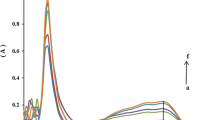Abstract
Sol–gel entrapment method was used to entrap bromothymol blue (BTB) pH indicator into mesoporous silica materials in the presence of cationic surfactants: 2-(hexadecyloxy)-2-oxoethyl-N,N,N-triethyl ammonium iodide (16E1Q) and 2-(hexadecyloxy)-2-oxoethanaminium-p-toluene sulfonate (16E1QS). The use of this new family of surfactants has modified the morphology and porosity of silica host matrix for better sensing capability and for faster response toward pH change. The physical interactions between BTB molecules and host mesoporous silica network were based on the nature of the surfactant. The presence of surfactants has shifted pKa values of more basic in comparison with that of BTB-entrapped silica system.
Graphical Abstract
















Similar content being viewed by others
References
Buntem R, Intasiri A, Lueangchaichaweng W (2010) Facile synthesis of silica monolith doped with meso-tetra(p-carboxyphenyl)-porphyrin as a novel metal ion sensor. J Colloid Interface Sci 347:8–14
Jeronimo PCA, Araujo AN, Montenegro M (2007) Optical sensors and biosensors based on sol–gel films. Talanta 72:13–27
Walcarius A, Collinson MM (2009) Analytical chemistry with silica sol–gels: traditional routes to new materials for chemical analysis. Annu Rev Anal Chem 2:121–143
Tan J, Wang HF, Yan XP (2009) Discrimination of saccharides with a fluorescent molecular imprinting sensor array based on phenylboronic acid functionalized mesoporous silica. Anal Chem 81:5273–5280
Terry LA, White SF, Tigwell LJ (2005) The application of biosensors to fresh produce and the wider food industry. J Agric Food Chem 53:1309–1316
Islam S, Rahman RA, Othman Z, Riaz S, Naseem S (2014) Synthesis and characterization of hybrid matrix with encapsulated organic sensing dyes for pH sensing application. J Ind Eng Chem 20:4408–4414
Islam S, Bidin N, Riaz S, Rahman RA, Naseem S (2015) Mesoporous SiO2–TiO2 nanocomposite for pH sensing. Sens Actuators B Chem 221:993–1002
Livage J, Coradin T, Roux C (2001) Encapsulation of biomolecules in silica gels. J Phys Condens 13:R673–R691
Miled OB, Grosso D, Sanches C, Livage J (2004) An optical fibre pH sensor based on dye doped mesostructured silica. J Phys Chem Solids 65:1751–1755
Rottman C, Grader G, Hazan YD, Melchior S, Avinir D (1999) Surfactant-induced modification of dopants reactivity in sol–gel matrices. J Am Chem Soc 121:8533–8543
Brinker GW (1989) Scherer sol–gel science, the physics and chemistry of sol–gel processing. Academic press, San Diego
Zaggout F (2006) Encapsulation of bromothymol blue ph-indicator into a sol–gel matrix. J Dispers Sci Technol 27(2):175–178
El Nahhal IM, Zourab SM, El-Ashgar NM (2001) Encapsulation of phenolphthalein pH-indicator into a sol–gel matrix. J Dispers Sci Technol 22:583–589
El Nahhal IM, Zourab SM, Kodeh FS, Al-Bawab A (2010) Behaviour of phenol red pH-sensors in the presence of different surfactants using the sol–gel process. J Environ Anal Chem 90:644–656
El Nahhal IM, Zourab SM, Kodeh FS (2012) Thin film optical BTB pH sensors using sol–gel method in presence of surfactants. Int Nano Lett 2:1–9
Orioni B, Roversi M, La Mesa C, Asaro F, Pellizer G, D’Errico G (2006) Polymorphic behavior in protein-surfactant mixtures: the water-bovine serum albumin-sodium taurodeoxycholate system. J Phys Chem B 110:12129–12140
Zhou T, Ao M, Xu G, Liu T, Zhang J (2013) Interactions of bovine serum albumin with cationic imidazolium and quaternary ammonium gemini surfactants: effects of surfactant architecture. J Colloid Interface Sci 389:175–181
Pi Y, Shang Y, Peng C, Liu H, Hu Y (2006) Interactions between bovine serum albumin and gemini surfactant alkanediyl-α, ω-bis(dimethyldodecyl-ammonium bromide). J Jiang Biopolym 83:243–249
Mir MA, Gull N, Khan JM, Khan RH, Dar AA, Rather GM (2010) Interaction of bovine serum albumin with cationic single chain+ nonionic and cationic gemini+ nonionic binary surfactant mixtures. J Phys Chem B114:3197–3204
Hu M, Wang X, Wang H, Chai Y, He Y, Song G (2011) Fluorescence spectroscopic studies on the interaction of Gemini surfactant 14-6-14 with bovine serum albumin. Luminescence 27:204–210
Caetano W, Ferreira M, Oliveira ON Jr, Itri R (2004) Enhanced stabilization of aerosol-OT surfactant monolayer upon interaction with small amounts of bovine serum albumin at the air-water interface. Colloids Surf B Biointerfaces 38:21–27
Bharmoria P, Rao KS, Trivedi TJ, Kumar A (2013) Biamphiphilic ionic liquid induced folding alterations in the structure of bovine serum albumin in aqueous mediumJ. Phys Chem B 118:115–124
El-Nahhal IM, Zourab SM, Kodeh FS, Abdelsalam FH (2014) Sol–gel encapsulation of bromothymol blue pH indicator in presence of Gemini 12-2-12 surfactant. J Sol–Gel Sci Technol 71(1):16–23
Kuswandi B, Fikriyah CI, Gani AA (2008) An optical fiber biosensor for chlorpyrifos using a single sol–gel film containing acetylcholinesterase and bromothymol blue. Talanta 74(4):613–618
Lobnik A, Majcen N, Niederreiter K, Uray G (2001) Optical pH sensor based on the absorption of antenna generated europium luminescence by bromothymol blue in a sol–gel membrane. Sens Actuators B Chem 74(1–3):200–206
Abdel-Salam FH, Baker SA (2015) Accepted in Tenside Surfactant and Detergent 2015
Acknowledgments
The authors would like to thank the Chemistry Department of Al-Azhar University of Gaza for their generous support for funding this research.
Author information
Authors and Affiliations
Corresponding author
Rights and permissions
About this article
Cite this article
El-Nahhal, I.M., Zourab, S.M., Kodeh, F.S. et al. Sol–gel entrapment of bromothymol blue (BTB) indicator in the presence of cationic 16E1Q and 16E1QS surfactants. J Sol-Gel Sci Technol 79, 628–636 (2016). https://doi.org/10.1007/s10971-016-4044-x
Received:
Accepted:
Published:
Issue Date:
DOI: https://doi.org/10.1007/s10971-016-4044-x




